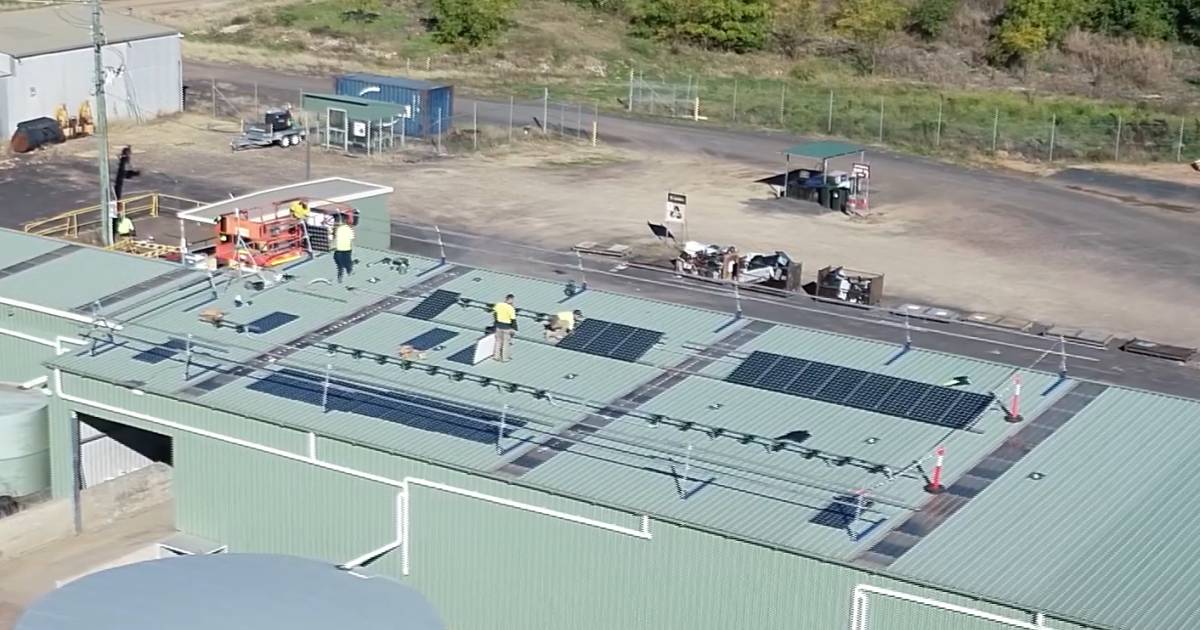
Pre-loved solar panels are continuing their service lives on the rooftop of a Dubbo Regional Council building.
Rooftop solar is a growing source of waste – but some discarded panels will have many good years left in them. These still serviceable panels often wind up unwanted as a result of solar system upgrades; or full systems being replaced for whatever reason.
In November last year, Dubbo Regional Council (DRC) was chosen to participate in a pilot project funded under NSW’s Circular Solar Grants program. The initiative was looking to give serviceable solar panels that may have otherwise ended up in landfill a second life.
Council’s main role in the project is hosting the system comprised of second-hand solar panels that have been installed – quite fittingly – on the Small Vehicle Receival Centre at the Whylandra Waste and Recycling Centre. The 8kW installation was completed last month.
“By participating in this trial, we are boosting the service life of solar panels, and increasing the uptake of renewable energy, helping to meet Council’s 50% renewable energy target,” said Council’s Manager Resource Recovery & Efficiency, John Wisniewski.
DRC also has other PV installations, some including Australian-made panels.
Small-scale PV Popular In Dubbo
Mr. Wisniewski says Dubbo is the second largest installer of small-scale systems in New South Wales.
“So if we can find extended uses for our solar panels, we’ll be reducing our overall environmental footprint.”
In Dubbo, solar panels are certainly a common sight. As at the end of May this year more than 9,513 small-scale (<100kW) solar power systems had been installed in the 2830 postcode, with a collective capacity of around 47.7MW. Given a population of 40,580, this works out to 1,175 watts per person compared to a 732 watts Australian per capita total.
Dubbo Regional Council hopes that through its participation in this trial that one day residents will be able to reuse unwanted panels on their own homes or businesses. On a related note, there’s also a lot of work being done elsewhere on developing standards and certification to support a local second-hand solar panel market.
James McGregor from the Blue Tribe Company – which is running the project in partnership with Solar Professionals and the NSW Office of Energy and Climate Change – said:
“We couldn’t think of a better place to trial this than at DRC’s Whylandra Waste and Recycling Centre in the heart of one of the leading solar communities in Australia.”
Councils across Australia have played an important role in promoting solar energy uptake, often walking the talk by installing panels on their own assets. It’s great to see a local government also pioneering in utilising second-life solar here.
The NSW Government created the $10 million Circular Solar grants program in an effort to find better ways of tackling how PV waste is handled. Phase 1 of the program awarded $2.1 million in funding for two projects last year, and Phase 2 saw $7.4 million for five projects; announced last month.
Related: (Good) Solar Installers In Dubbo.

 RSS - Posts
RSS - Posts



How can you tell if a solar panel still has some life in it?
Are you kidding?
Put the panel in sunlight, connect a variable load to match the panel’s rated maximum output and measure its performance such as Voc/Vsc and Ioc/Isc. Sure, some panels may degrade over time and do a visual inspection for cracks, etc. Not all 2nd hand solar panels are bad. Most owners want to upgrade their system before the warranty even runs out.
It’s no different how you test a 2nd hand car, take it out for a drive.
But my question is, how does the CEC see this? Are there exceptions to be made if the panel is no longer on approved products for grid connection?
Imagine, if we applied the same rules to cars? There’d be an outrage if every 5 years, 2nd hand cars were made to be no longer approved to be driven on the roads. Why should 2nd hand solar panels and inverters not allowed to be reconnected to the grid? If they were tested and passed electrical safety, then they should be able to be reconnected.
Lots of people buy 2nd hand electrical appliances but it seems solar panels and inverters are the only ones exclusively marked not to be reconnected to the grid if they are no longer on the CEC’s approved list of solar equipment. I get solar inverters may have outdated firmware, but solar panels have no active software/firmware on them, so why make solar panels no longer approved to be re-used for a grid tied system if they still work?
Maybe it’s a conspiracy to force people to buy new panels instead of using 2nd hand panels but this creates a dilemma of waste.
No, I wasnt kidding. If someone were to declare my solar panels to be useless I would not be able to do the things you suggest—-dont even understand the terms you used. It would be good to know a test for ordinary people to use. I have had car salesmen tell me that my car was about to fall apart……..